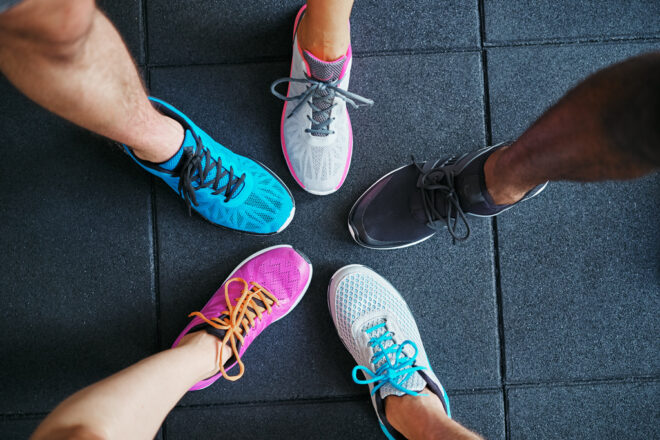Do your shins hurt after running? If you run a lot, chances are you’ll get shin splints eventually.
Shin pain when running has a medical name – medial tibial stress syndrome (MTSS). As you can tell from the name, the condition is caused by stress on your tibia or shinbone.
“Why do my shins hurt when I run?” you may be wondering. Your shoes may be to blame. Read on to discover the best running shoes for shin splints and learn more about the causes of this common condition.
In This Article:
What Are Shin Splints?
Shin splints is pain along or behind the front of the large bone in the lower leg. Repeated stress from overtraining or bad running form is often what causes shin splints.
Other causes include bad running form, overpronation, training on hard surfaces, underdeveloped hip or leg muscles, ankle joint tightness, and using the wrong running shoes.
What do shin splints feel like?
Shin splints pain is caused by microtears in the bone and muscle tissue. Swelling and outside calf pain are common.
Shin splints feel like soreness or pain along the inner side of your shin, which occurs when you run. It may go away when you stop exercising. Swelling in the lower leg may also occur.
While shin splints may cause a bruised shin, this may also be the result of muscle or tendon damage or a fracture. It’s important to rule out those first.
How long do shin splints last?
Shin splints can last for 4 weeks. If your legs get enough rest, they may go away sooner. Depending on the cause behind your shin splints, stabilizing devices like an ankle splint may help. But if you put further stress on your legs, shin splints may remain with you for a long time.
If the shin pain doesn’t go away or is severe, you want to see a doctor as shin pain is not always shin splints.
For example, pain on the outside of the shin can indicate compartment syndrome, a type of shin muscle injury. A sharp point of pain along your shin could mean a stress fracture, a potential complication of shin splits.
Best Running Shoes for Shin Splints
Using the wrong running shoes or hitting the ground in worn-out shoes can lead, in combination with other factors, to shin splints.
A systematic review of the role of footwear design found that minimalist running shoes can increase the risk of running injury. It also noted that while thick and soft midsoles provide good cushioning, they may contribute to a poor running gait by decreasing your sensation of touching the ground.
The best shoes for shin splints hit the soft spot between cushioning, lightness, flexibility, and stability.
With that in mind, we’ve put together a list of the best shoes for shin splints. Explore it now.
Brooks Adrenaline GTS 21: best men’s running shoes for shin splints
The Brooks Adrenaline GTS 21 can help you make shin splints a thing of the past. A mix of superior shock absorption and excellent DNA cushioning that adapts to your foot and stride makes this shoe stand out.
This pair includes a holistic support system that promotes running in your natural path. It’s super comfortable too. Getting used to these shoes won’t take long.
Add to that its light weight and breathability, and you’re looking at a great running shoe all-around.
Hoka One One Clifton 6: best women’s running shoes for shin splints
Soft cushioning makes the Hoka One One Clifton 6 excellent at shock absorption, which is what you need when you’re dealing with (or trying to prevent) shin splints.
The flexible foam midsole reduces pressure under the heel and ball of the foot. That, together with its light weight, makes this an above-average running shoe.
If shin splints are a recurring problem, excellent cushioning may help you better manage them, and this Hoka One shoe provides just that.
Saucony Triumph 18: best for road running
Talking of cushioning, here’s another shoe that does that better than most – the Saucony Triumph 18.
Specially designed for road runs, it has a high heel-to-toe ratio (more about this in a bit) and locks in your heel to help improve your gait. You’ll also like the traction it provides.
One thing to note is that this shoe is not lightweight and that the narrow toebox doesn’t make it ideal for wide feet.
Adidas Adizero Adios 5: best all-purpose shoes
The Adizero Adios 5 series from Adidas is a versatile running shoe you can use for different race types, including sprinting and long-distance running.
Noted for its light weight, Adizero Adios 5 provides stability, comfort, and good breathability. The toe room isn’t bad either.
Overall, this is a reliable and convenient shoe that can help you manage shin splints without breaking the bank.
New Balance Fresh Foam 1080v10: best for wide feet
Coming across a promising pair of running shoes only to find out they’re not wide enough for your feet can be disappointing.
But with New Balance Fresh Foam 1080v10, you don’t have to worry about that. Available in multiple widths, including extra-wide, this stable and comfortable running shoe provides effective foam support for the midsole. You’ll also like its overall flexibility.
Asics GEL-Nimbus 23: best for distance runners
Asics’s GEL line of shoes for runners with their 3D Space Construction is built to make your long-distance rides stable and smooth.
Asics GEL-Nimbus 23 absorbs shocks effectively and provides excellent cushioning at the foot strike, making your stride less hard on your feet.
You can also count on this brand for durability whether you’ve already signed up for a marathon or are still in the process of training for one.
Brooks Addiction 14 at Amazon: best for pronation control
When your ankle rolls too far downward and inward as you run, you’re overpronating. Feet rolling inward as you hit the ground can lead to shin splints.
The Brooks Addiction 14 provides enough stability to help with controlling pronation. You can easily add orthotics to it to further improve alignment and support.
You’ll also like its super-soft cushioning and generous fit.
What to Look for in Running Shoes for Shin Splints
When selecting running shoes, the American College of Sports Medicine (ACSM) recommends picking a shoe that protects your feet against injury without providing excessive cushioning.
Tip: Feet can swell during the day, which is why it’s best to buy your running shoes at the end of the day to make sure they fit comfortably.
A safe running shoe matches your foot arch and can absorb shocks. It’s lightweight and durable and has a minimal heel-to-toe drop, a wide toe box, and provides a good fit. Your heel should not slip when you run. Breathability and appropriate stiffness are two other notable features, according to this study.
Important: The rule of thumb is to change your running shoes every 350 miles or as soon as wear causes the layers of the sole underneath to be exposed.
Now let’s take a closer look at the characteristics of a good running shoe.
Type
General-purpose running shoes are better for running than your average sneakers. But you also want to consider what type of running you’ll be doing.
If you do long-distance running, get a pair of marathon shoes rather than sprinting shoes. In this way, you’re more likely to pick a shoe optimized for all the key running footwear features recommended by experts in this study.
These include crash pad, bending stiffness, midsole thickness, and upper breathability. Manufacturers of regular sneakers may not take these into account.
Cushioning
The moment your foot strikes the ground, both the foot and leg receive a shock. Running on hard surfaces such as concrete increases this shock. Cushioning in a running shoe helps reduce the shock and is a key feature of long-distance running shoes.
Fit
Trying the shoe for yourself is the best way to decide if it fits well. If your feet are wider or narrower than most, getting the right fit is crucial. When comparing shoes, find out what other people have to say about how the shoe fits.
Heel-to-toe drop
This is the difference in height between the amount of material under the forefoot and that under the heel of a running shoe. A running shoe with a heel-to-toe-drop of 5mm has 25mm of material under the heel and 20mm under the forefoot.
A low heel-to-toe-drop means a more uniform thickness under the foot. A low value is best if you land midfoot or front foot, while a higher drop (think 7mm or higher) is better if you constantly heel strike.
Heel cup support
Another source of impact when running occurs when the heel hits the ground. Heel striking is considered by many a bad running form, but some amount of heel striking is unavoidable.
Over 90% of marathoners heel strike, according to this study. Heel cup support reduces the impact of heel strikes and complements the rest of the support and cushioning good running shoes provide.
Midsole support
Midsole support can further absorb shock during the moment when the foot strikes the ground. It reduces the impact on your foot and can help reduce the risk of running injuries over long distances. Running shoes tend to have a thicker midsole than other shoes.
What to Avoid
When shopping for running shoes for shin splints, it’s not only a question of features you should get but also of some you may be better off avoiding.
Here’s how to prevent shin splints by avoiding some common mistakes.
Choosing running shoes based on your walking gait
Asking someone to check your walking gait and then choosing running shoes based on that is not a good idea. Your walking gait differs from your running gait.
High and thick cushioning
According to ACSM, soft cushioning may make you land with greater impact compared to having less cushioning. It may also lead to worse biomechanics when running.
The idea is not to give up cushioning but simply not to go over the top with it. Getting extra cushioning for the sake of it is not beneficial.
High-to-toe drop
A high profile in a running shoe may increase the risk of injury, especially if your foot feels unnatural in that position.
Stability features
When it comes to running, features like extra arch support may get in the way rather than help. They can put extra strain on your feet.
Uncomfortable fit
A running shoe may check all the boxes and look cool too. But if it feels uncomfortable, keep searching.
FAQs
Can running shoes prevent shin splints?
Wearing comfortable running shoes that fit your gait can help you prevent shin splints. This is especially true if you’re currently using worn-out shoes or shoes not designed for running.
That said, keep in mind that shin splints can have multiple causes, including overtraining, underdeveloped leg muscles, or bad workout habits.
Is it ok to run with shin splints?
If you feel shin splints while still running, it’s a good idea to rest. Running with the pain can make it worse and increase the risk of pressure fracture and getting sidelined for a long time.
Resting, icing, and stretching can help you get rid of the pain. If you have shin splints for more than 3 to 4 weeks, consider seeing a doctor.
What exercise is best for shin splints?
Good shin splints exercises include calf strengthening moves like seated calf raises and standing calf raises. You want to stretch both calf muscles.
Similar to other running injuries, you also want to do stretches. In addition to doing exercises that stretch the calves, stretch the Achilles tendon and the anterior tibialis muscle.
How can you prevent shin splints?
Shin splints are not just something that happens to runners. You can even get shin splints from walking. Going from sedentary to active or overtraining often causes them.
Ideally, you want to follow a personalized training plan and increase your workouts in increments rather than going full out. Make sure to work your leg muscles to strengthen them and work on improving your running form.
Also, wear comfortable running shoes with good but not excessive cushioning, and preventing shin splints will become easier.
Do compression socks help with shin splints?
Compression socks for shin splints may help by increasing oxygen and blood flow to your shins. This may boost your muscle endurance and make your muscles work more efficiently. More research is needed on this, but they’re worth trying.
How can I treat shin splints?
Rest is crucial if you’re wondering how to get rid of shin splints – stop running for about two weeks. You can still walk or swim during this time to stay active. In addition to rest, you can ice your shin for 30 minutes every 4 hours until the pain is gone.
Keeping your legs elevated, wearing compression bandages, and using a foam roller for massaging your shins may also help.
Change your running shoes if necessary and use orthotics. If the pain persists, talk to your doctor – they may prescribe anti-inflammatory medication.
In many cases, realizing you have to take it easier and doing so will make shin splints go away.
Happy running!














